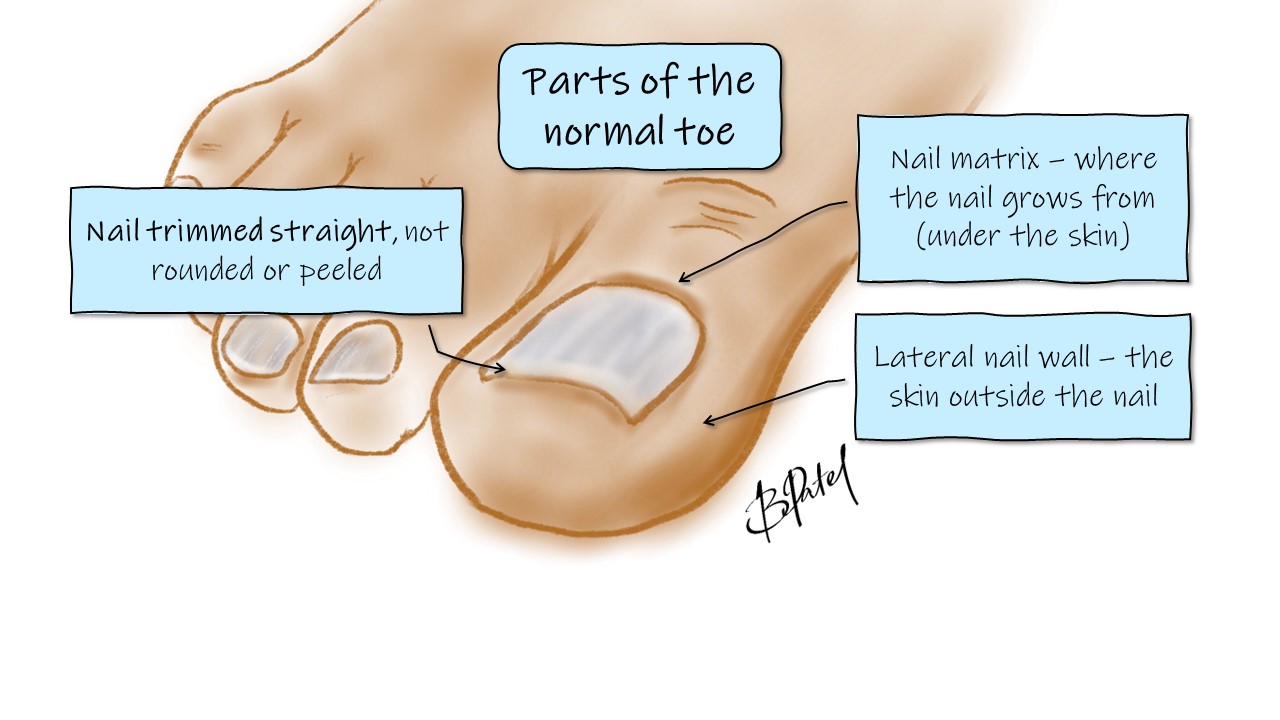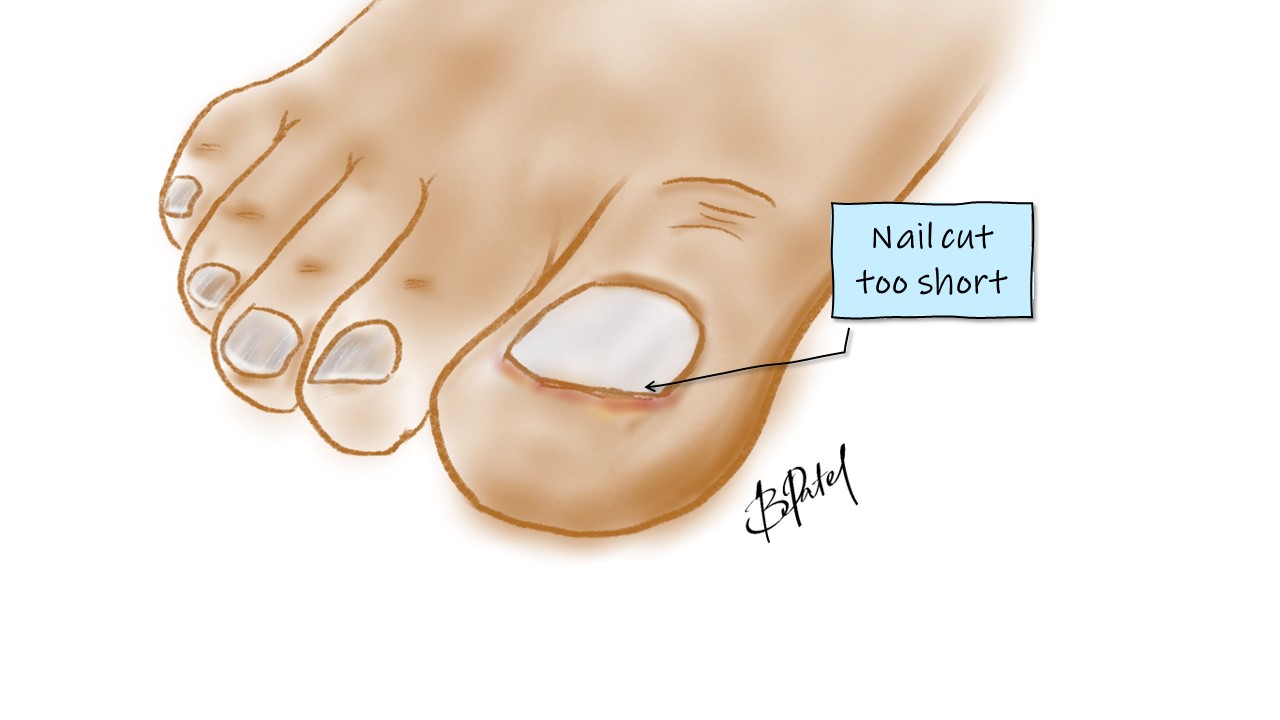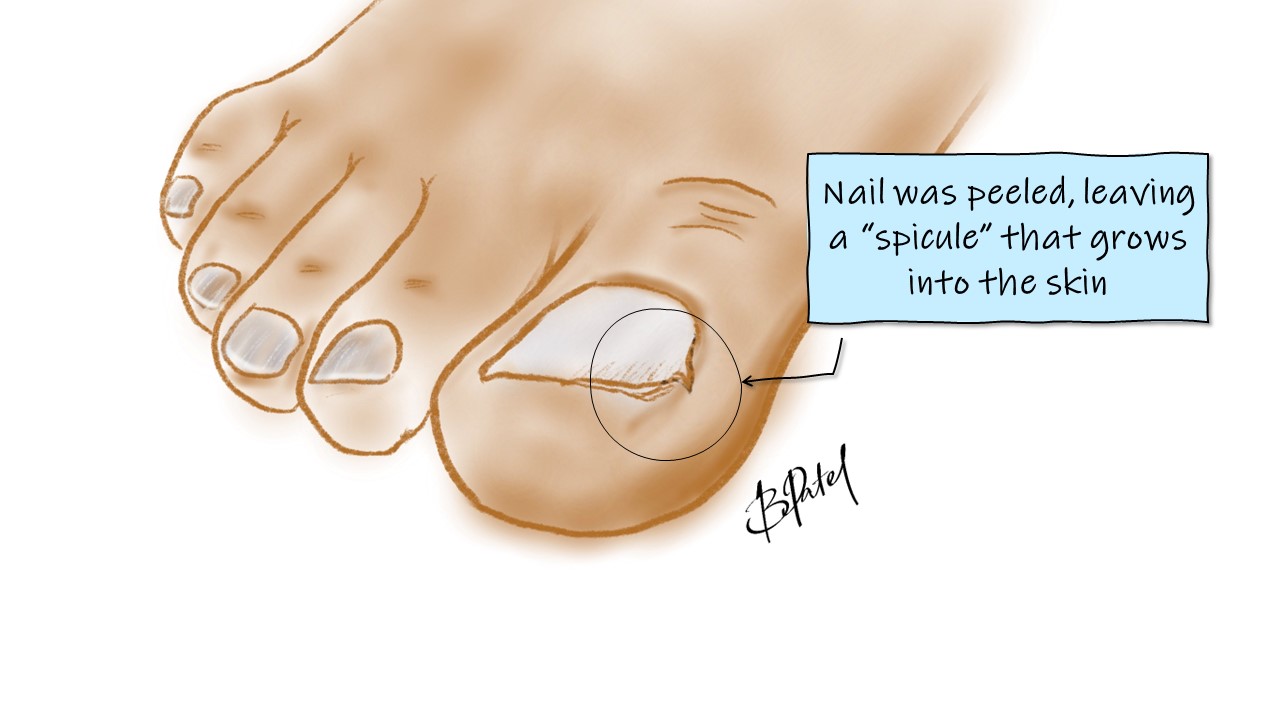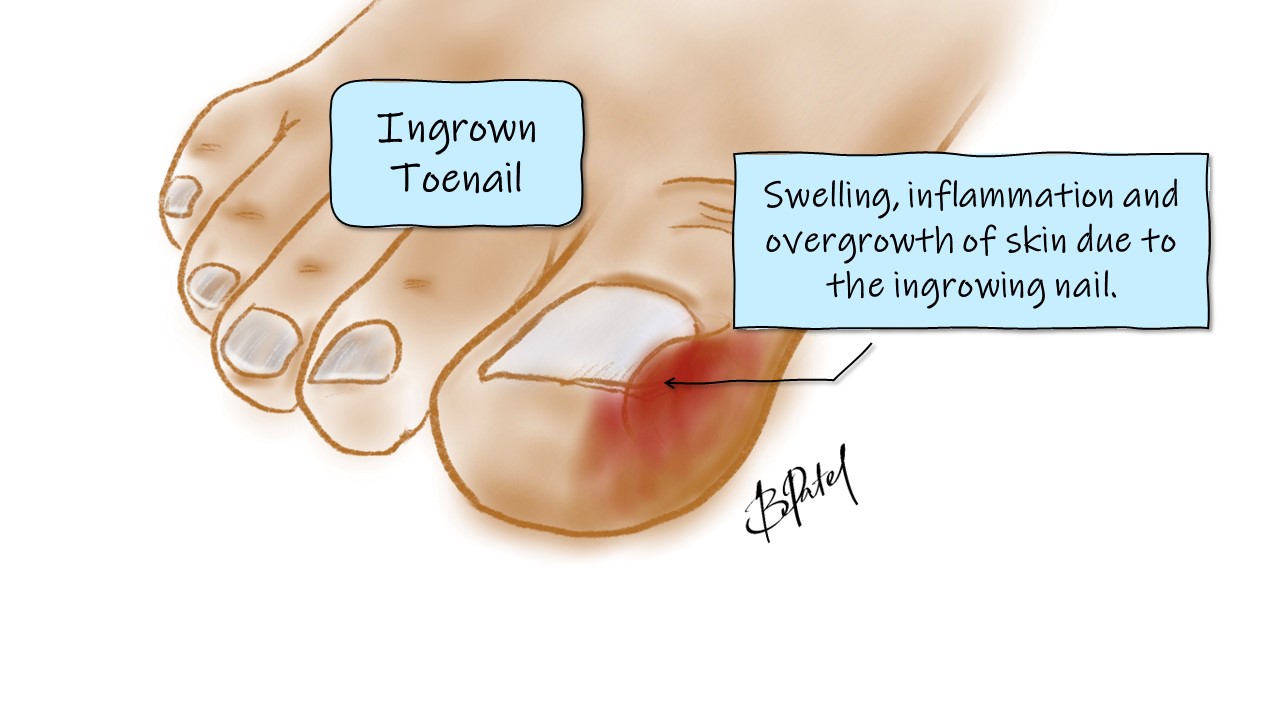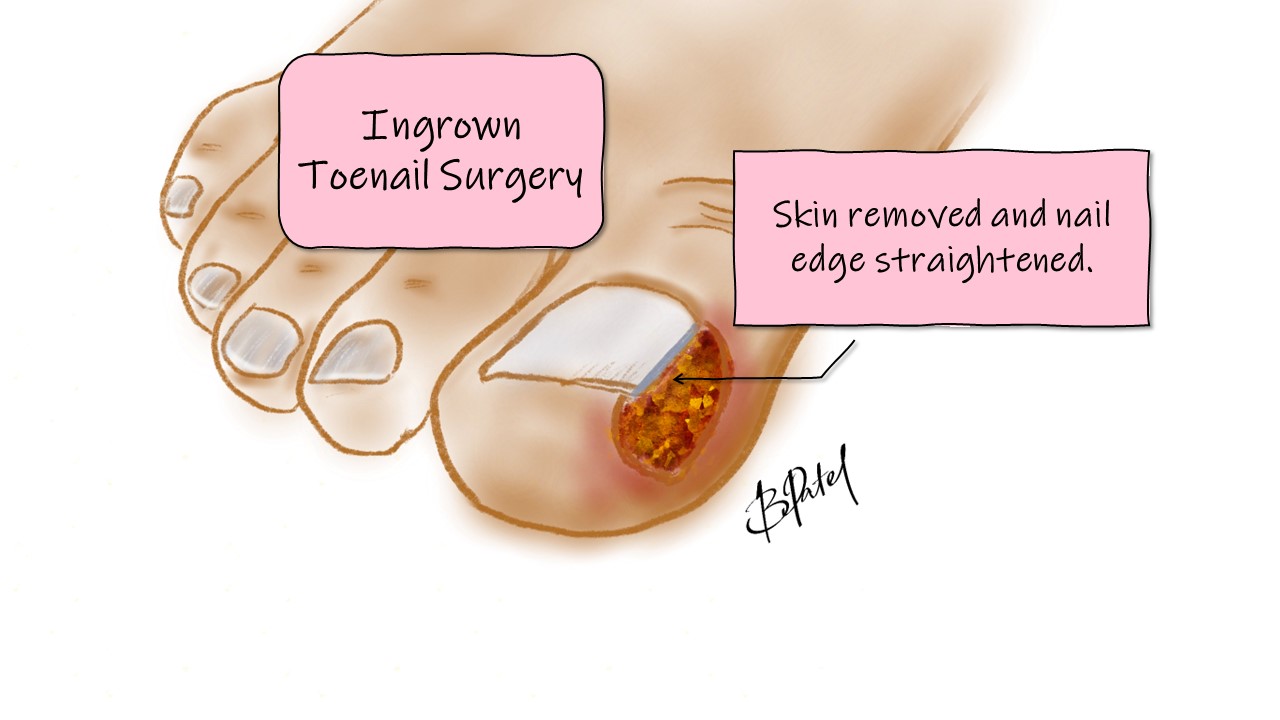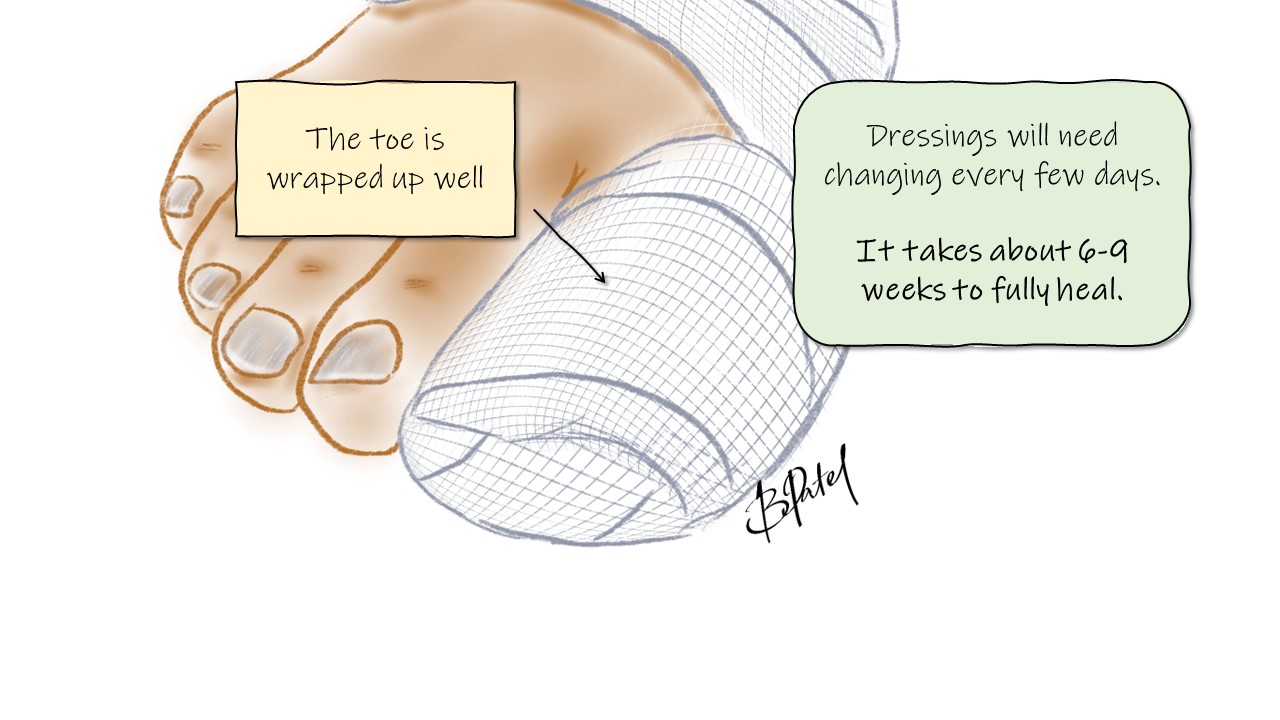Ingrown Toenails
A condition where the edge of the toenail grows into the surrounding skin, causing pain, swelling and infection. It is also called Ingrowing toenails, and mainly affects the great toe in children.
The Condition
What is an ingrown toenail?
An ingrown toenail is a common condition where the nail grows into the skin instead of over it, primarily affecting the big toe.
This often results in pain, redness, swelling, and sometimes infection. The skin overgrows over the nail, making the problem even worse, and difficult to treat.
-
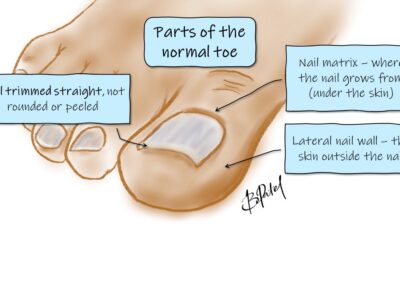
Normal Toe
-

Spicule of nail - causes ingrowing
-
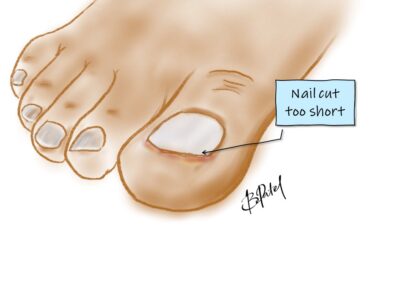
Nail cut too short - causes ingrowing
-

Ingrown toenail
-
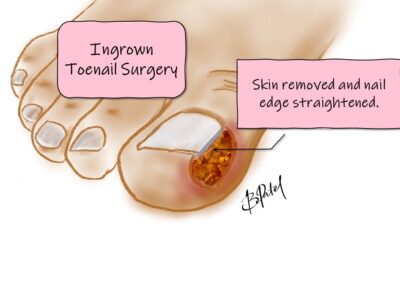
Ingrown toenail surgery
-
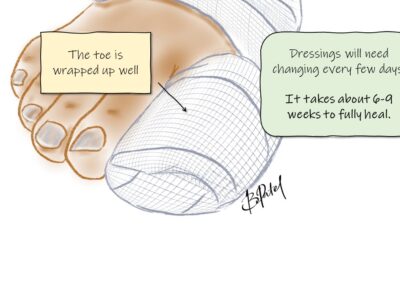
Ingrown toenail surgery dressings
Why does it occur?
- Improper nail trimming – too short, or peeling the nail
- Wearing shoes that are too tight
- Injury
- It is most frequent among teenagers and young adults due to growth spurts and footwear choices
- Sometimes its the gait (the way you walk) if you’re putting too much weight on one side of the toe
Does it need repair?
If medical care and prevention strategies don’t work, surgery may be required.
With skin overgrowth, it takes a very long time for the ingrown nail to grow out from the skin on the side. In that time, there will be repeated infections. Soaks, lifting the nail and pulling the side skin can help.
When it the skin overgrowth is just too much, then surgery to remove that skin becomes a better option.
Can it be prevented?
With the right measures, yes.
- Clean the area often.
- The nails should not be peeled or picked.
- Nail cutting needs to be straight, oud outside of the skin area. Not too short.
- Keep lifting the nail out of the skin.
- Get your gait (the way you walk) analysed by a physiotherapist or podiatrist. You may be putting a lot of weight on one part of the toe and allowing the nail to dig in.
- Podiatrist assessment for correct fitting of shoes.
Treatment
Surgical repair
We perform surgery under general anaesthesia, so your child will be fully asleep, won’t feel it, nor remember the procedure. A nerve block is done, so the area is numb for several hours after the procedure.
Antibiotics are given at the start of the procedure.
The overgrown skin that the nail is growing into is removed, leaving a raw area. Some call this a “Willett’s procedure”.
In some cases, the area that the nail grows from also needs to be “ablated” – this is where we try to stop the nail from growing so far out – a further cut is made where the nail grows from. This is sometimes called a “Wedge resection”.
How long does the operation take?
The operation takes about 20 minutes.
The anaesthetic can take at least 20 minutes before and after so you’ll be away from your child for an hour or so until they are ready for you in the recovery room. You will be notified when they are ready for you to see them in recovery.
When should the repair be done?
Whenever the medical treatments are not working for you, or you’ve tried other options without success.
What are the risks of the operation?
- The anaesthetic – airway and breathing issues are extremely rare.
- There are standard risks of any operation. These include bleeding and bruising and wound healing problems such as infection. A scar always develops, although is fairly hidden due to the methods used.
- Expect the area to take about 6-9 weeks to heal.
- When using the ablation technique, there is a higher risk of infection in the bone, and the nail may not grow correctly afterwards.This is rare.
- If the correct prevention strategies are not used, recurrence is very likely.
Recovery
What happens after the operation?
Recovery – you will be called into the recovery room just after they are awake.
Feeding – you can feed in the recovery room.
Home – usually after a few hours, once the nursing team have ensured your child is safe, comfortable.
Activity – The foot needs to be elevated for 2 days, to help with swelling and pain.
Bathing – The foot needs to be kept dry while the dressing is on. Later when the dressing is changed it can be washed.
Sports / School – older children / teens will need 1-2 weeks off school and at least 6 weeks off sports.
Swimming can resume once there is no more dressing on the wound.
Nail training – after 2-3 weeks, as the wound is healing, we will show you how to keep the nail up and out of the skin to prevent recurrence.
The wound / Dressings
We place a special silver based dressing on the wound, which helps with infection and inflammation. This is taped in place and the whole toe and foot wrapped in a “crepe” bandage
The area will become swollen and bruised.
It is really important to keep the foot elevated for 2 days to let the swelling reduce. This will also help with pain.
You’ll need to make plans with your GP / practice nurse to have regular dressing changes. The first change is about 5-7 days, and depending on how it looks you’ll make plans accordingly.
There will be regular checks with your surgeon too. Often we alternate with the GP. We’ll make plans that suit you.
Overall expect to have dressings for about 6 weeks.
After 2-3 weeks, you’ll be able to dress and clean the area at home. You’ll need to start training the nail after this time too.
Pain relief
Your child will receive good pain relief in the operating room, that will last a few hours.
After the operation they will need paracetamol and possibly ibuprofen (eg. Nurofen) for a few days. Please let your surgeon and anaesthetist know if your child has intolerances or allergies.
In order to avoid medication, aim to distract your child and keep their mind off the area.
Having the foot elevated for the first 2 days will help a lot.
Normal activity / Footwear
Going to the toilet – you’ll be able to go, but keep your foot elevated for the first 2 days in between toileting.
Bathing – Keep the dressings dry.
Daycare / School – usually 1-2 weeks
Swimming – can resume when there is no more dressing.
Sports – about 6 weeks depending on how the area is healing.
Footwear – often you will need large shoes to fit the dressing. The preference is to avoid shoes. If going to school, we can provide a letter to support wearing non-standard shoes. You will need to be careful of other children standing on your feet!
Troubleshooting
It is very sore / throbbing
This often happens if the foot is not elevated enough in the first 2 days.
Keep the foot elevated and take pain relief. If no improvement the dressing may need to be loosened. Call your surgeon or go to the nearest emergency department. The wrap dressing can often be undone, and the inner dressing can remain intact.
The dressing is dirty / soiled.
If there is bleeding, and the dressing has become quite blood stained, please call your surgeon for further advice. If afterhours, you may need to go to the emergency as they will have the supplies and expertise to help at that time.
If the dressing is soiled from the outside. because so many layers of dressing are used, it often doesn’t reach the wound itself. Call your surgeon and we can discuss further. If a GP appointment is convenient then that may work too.
What are the next steps?
The first dressing change is around 5-7 days with your GP, who should have received notification and information about the procedure prior.
You will have made an appointment with your surgeon as well, usually for the week after.
We will go through the education of training of the nail with you. This usually requires tape, or cotton buds.
Have some betadine ointment too, which can help with infection and wound healing.
What do I look for?
You know your child best. If you have any concerns please see your family doctor or call your surgeon. The list below are issues that require medical attention.
- Increasing pain or persisting pain despite pain relief
- Increasing swelling or bleeding.
- Fever >38.2 degrees Celsius
- Vomiting and feed intolerance
- Discharge or bleeding from the wound.
Experienced Surgeons
Over 25 years experience in paediatric surgery
Locations
Queensland and northern New South Wales
Appointments
Prioritised time for your child
Information
Conditions, procedures and aftercare
In the spirit of reconciliation we acknowledge the Traditional Custodians of country throughout Australia and their connections to land, sea and community. We pay our respect to their Elders past and present and extend that respect to all Aboriginal and Torres Strait Islander peoples.


